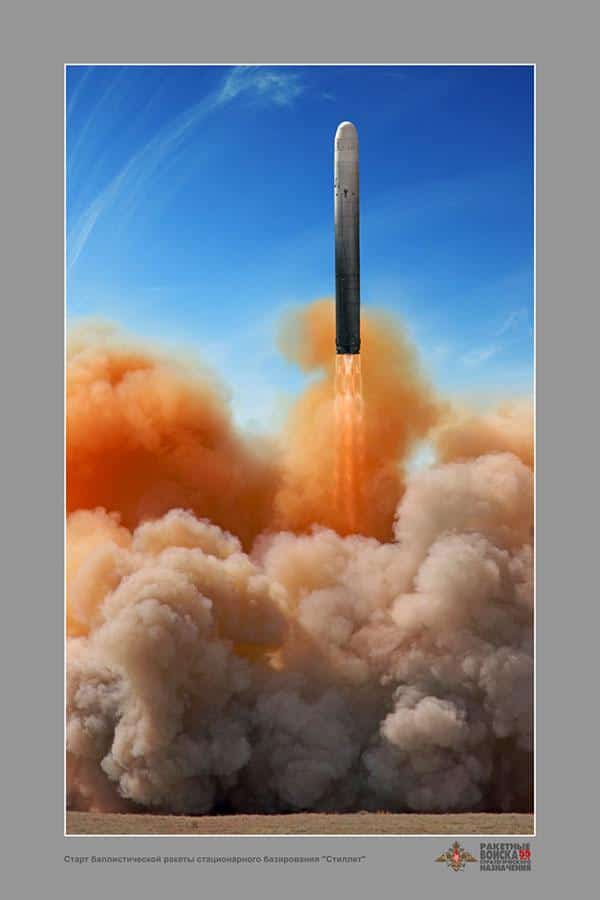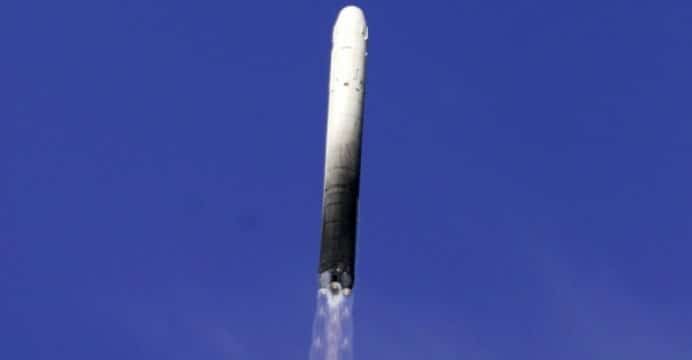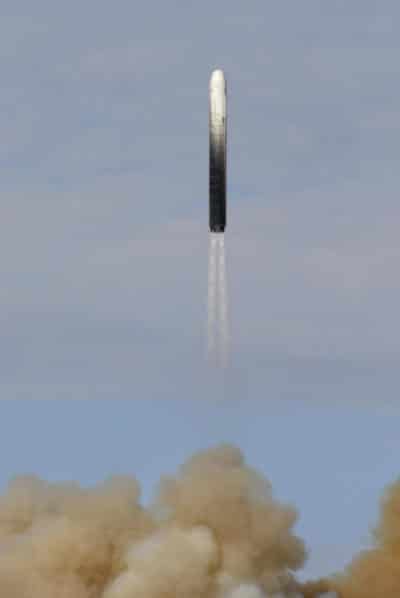The UR-100 (NATO: SS-19 “Stiletto”) s an intercontinental-range, silo-based, liquid propellant ballistic missile system deployed by the Soviet Union and now the Russian Federation. Designed concurrently with the SS-17, with which it shares many features. SS-17, SS-18, and SS-19 were the first Soviet missiles to be equipped with Multiple Independent Reentry Vehicle (MIRV) warheads with separate guidance and targeting systems. The old MRV systems were not independent and simply saturated a single target area with warheads.1
There have been three models of the SS-19 (RS-18), the Mod 1, in service from 1975-1983, and the Mod 2, from 1977 to 1982, and the Mod 3, from 1980 to the present.
UR-100 (SS-19 “Stiletto”) at a Glance
- Originated from
- Russia
- Possessed by
- Russia
- Alternate names
- Stiletto, RS-18 Mod 1/2/3, UR-100N, UR-100NUTTH, 15A30, 15A35
- Class
- Intercontinental Ballistic Missile
- Basing
- Silo-based
- Length
- 24.0 m (Mod 1), 24.3 m (Mod 3)
- Diameter
- 2.50 m (Mod 1, 2,3)
- Launch weight
- 105,600 kg
- Payload
- Six MIRV, 3,355 kg
- Warhead
- Nuclear 500-600 kT, 750 kT option (Mod 2)
- Propulsion
- Two-stage liquid propellant
- Range
- 10,000 km
- Status
- Operational
- In service
- 1975-1983 (Mod 1), 1977-1982 (Mod 2) 1980-present (Mod-3)

UR-100 commemorative poster. Photo: Russia MoD 
UR-100NUTTH test launch. Photo: Russia MoD 
UR-100NUTTH test launch.
UR-100N (SS-19 Mod 1)
The Stiletto Mod 1 could deliver up to six MIRV warheads a maximum of 10,000 km, each with a nuclear yield of 500 kilotons (kT). 2 A digital guidance and control system was used with an inertial guidance system, resulting in a reported accuracy of 550 m CEP. The missile had a length of 24.0 m, a width of 2.5 m and a launch weight of 92,700 kg, and used a two-stage liquid propellant engine.3
The SS-19 entered development in 1968 with the first flight test of the Mod 1 taking place in April 1973. The missile entered service in 1975 as the last of the fourth generation Soviet land-based missiles, and was initially deployed in heavily modified SS-11 silos.
UR-100N (SS-19 Mod 2)
The Mod 2 was a single warhead version of the SS-19 which was briefly in service between 1977 to 1982. The USSR deployed a total of 60 of this variant, which were the first to be replaced with the MIRVed Mod 3.
UR-100NUTTH (SS-19 Mod 3)
Due to a rushed deployment timeline, earlier versions of the SS-19 were found to have accuracy issues at long ranges. Only a year after the deployment of the SS-19 Mod 1, the Soviets began a redesign of the missile to correct the flaw, along with other operational improvements and overall resilience, which resulted in the Mod 3. 4
The USSR began deployment of the Mod 3 in 1980. By 1983 all deployed SS-19 Mod 1 and 2 missiles were of the Mod 3 variety. The Mod 2 had a throw weight of 4,350 kg made up of six MIRVed warheads, with a nuclear yield between 550 to 750 kT. Like the previous Mods, the Mod 3 had a maximum range of 10,000 km with a somewhat reduced, but more reliable accuracy 900 m CEP. 5
By the time the Soviet Union dissolved in 1991, 300 SS-19 launchers were deployed. Of these, 130 were stationed in Ukraine. Ukraine claimed ownership of them and after its independence, subsequently dismantling the launchers. 6
As of 2016, 20 SS-19 launchers remain in service. 7
Avangard (SS-19 Mod 4)
Russia’s Avangard hypersonic glide vehicle (HGV) is presently fielded on a UR-100 booster and emplaced in existing UR-100 siloes. This variant is known to U.S. intelligence sources as the SS-19 Mod 4. The system houses the Avangard HGV in a nose fairing similar to the converted UR-100 ‘Strela’ space launch vehicle.
Space Launch Conversion
Some of the retired SS-19 launchers have since been converted into satellite-launch vehicles. There are two SLV versions, the ‘Rokot’ and the ‘Strela.’8 The ‘Rokot’ adds a third liquid stage to the SS-19 frame in order to send payloads weighing up to 1,850 kg into low Earth. The ‘Strela’ uses a modified payload bus as a third stage engine, presumably to launch lighter satellites than the ‘Rokot.’ The ‘Strela’ was tested in 2003, with subsequent satellite launches in 2013 and 2014.9
Footnotes
- “RS-18/UR-100N/15A30, 15A35,” in IHS Jane’s Weapons: Strategic 2015-2016, ed. James C. O’Halloran (United Kingdom: IHS, 2015), 94-95.
- Pavel Podvig, ed., Russian Strategic Nuclear Forces (Cambridge: The MIT Press, 2001), 220-223.
- “RS-18/UR-100N/15A30, 15A35,” in IHS Jane’s Weapons: Strategic 2015-2016, ed. James C. O’Halloran (United Kingdom: IHS, 2015), 94-95.
- Pavel Podvig, ed., Russian Strategic Nuclear Forces (Cambridge: The MIT Press, 2001), 220-223.
- “RS-18/UR-100N/15A30, 15A35,” in IHS Jane’s Weapons: Strategic 2015-2016, ed. James C. O’Halloran (United Kingdom: IHS, 2015), 94-95.
- Pavel Podvig, ed., Russian Strategic Nuclear Forces (Cambridge: The MIT Press, 2001), 220-223.
- Hans M. Kristensen & Robert S. Norris (2016) Russian nuclear forces, 2016, Bulletin of the Atomic Scientists, 72:3, 125-134, http://dx.doi.org/10.1080/00963402.2016.1170359.
- Pavel Podvig, ed., Russian Strategic Nuclear Forces (Cambridge: The MIT Press, 2001), 220-223.
- William Graham, “Russian Strela rocket launches Kondor-E,” NASA Spaceflight, December 18, 2014, http://www.nasaspaceflight.com/2014/12/russian-strela-launch-kondor-e/.